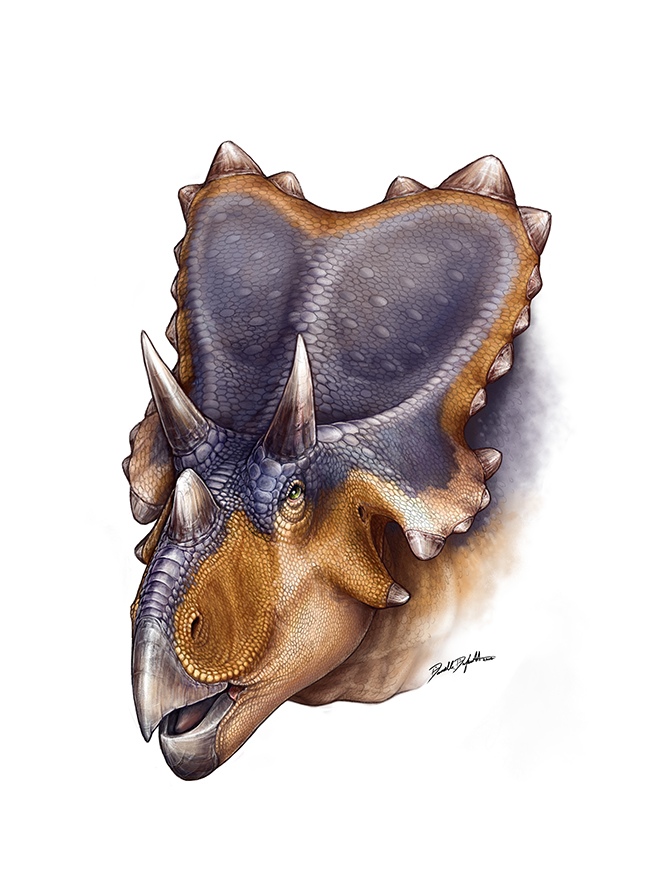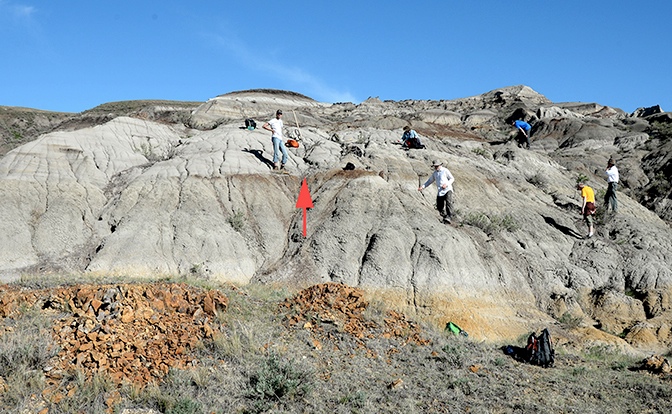Newfound Dinosaur Sported 'Wings' on its Head

Move over Triceratops: There's a new horned dinosaur in town, and its cranial ornamentation is even more impressive than the three-horned dinosaur the world has come to know and love.
A study of the recently discovered species, Mercuriceratops gemini, provides more details on this flashy dinosaur, which possessed not only the standard trifecta of facial horns, but also a giant, winglike frill protruding from the back of its skull.
"The butterfly-shaped frill, or neck shield, of Mercuriceratops is unlike anything we have seen before," said David Evans, co-author of the new study and curator of vertebrate paleontology at the Royal Ontario Museum in Canada, in a statement. "Mercuriceratops shows that evolution gave rise to much greater variation in horned dinosaur headgear than we had previously suspected." [See Images of a Flashy Horned Dinosaur]
The research describing the new species is based on fossil evidence collected from Montana as well as Alberta, Canada. Mercuriceratops gemini lived about 77 million years ago, during the Late Cretaceous Period, and was approximately 20 feet (6 meters) long and weighed more than 2 tons. Like Triceratops and other ceratopsid dinosaurs, Mercuriceratops was a plant-eating dinosaur, and researchers believe it had a parrotlike beak, as well as two long brow horns above its eyes.
Its headgear, though, is in a league all its own.
"Mercuriceratops took a unique evolutionary path that shaped the large frill on the back of its skull into protruding wings like the decorative fins on classic 1950s cars," said Michael Ryan, lead author of the study and curator of vertebrate paleontology at The Cleveland Museum of Natural History in Ohio, in the statement. "It definitively would have stood out from the herd during the Late Cretaceous."

The dinosaur's name, Mercuriceratops, is a combination of "Mercury" — the Roman God best known for his winged helmet — and "ceratops," a Greek word meaning "horned face." The second part of its name "gemini," is Latin for "twins" and refers to the fact that paleontologists uncovered two nearly identical specimens of the species, the first in north-central Montana and the second at the UNESCO World Heritage Site, Dinosaur Provincial Park, in Alberta, Canada.
Sign up for the Live Science daily newsletter now
Get the world’s most fascinating discoveries delivered straight to your inbox.
The study detailing the two findings, published online in the journal Naturwissenschaften, focuses on skull fragments of Mercuriceratops found at each site. Originally, scientists believed the specimen they had uncovered at the Judith River Formation of Montana was simply a distorted fossil from the remains of a more common ceratopsid species. But the discovery of a nearly identical specimen collected from the Dinosaur Park Formation in Alberta suggested otherwise.
"The Alberta specimen confirmed that the fossil from Montana was not a pathological specimen, nor had it somehow been distorted during the process of fossilization," said Philip Currie, professor and Canada research chair in dinosaur paleobiology at the University of Alberta, in the statement. "The two fossils — squamosal bones from the side of the frill — have all the features you would expect, just presented in a unique shape." (The squamosal bone is located in the skull of vertebrates.)
As to the question of why Mercuriceratopsdeveloped such a prominent skull ornament, the researchers presented a number of possibilities.
"Horned dinosaurs in North America used their elaborate skull ornamentation to identify each other and to attract mates — not just for protection from predators," Ryan said. "The winglike protrusions on the sides of its frill may have offered male Mercuriceratops a competitive advantage in attracting mates.”
Follow Elizabeth Palermo on Twitter @techEpalermo, Facebook or Google+. Follow us @livescience, Facebook & Google+. Original article on Live Science.

Elizabeth is a former Live Science associate editor and current director of audience development at the Chamber of Commerce. She graduated with a bachelor of arts degree from George Washington University. Elizabeth has traveled throughout the Americas, studying political systems and indigenous cultures and teaching English to students of all ages.









